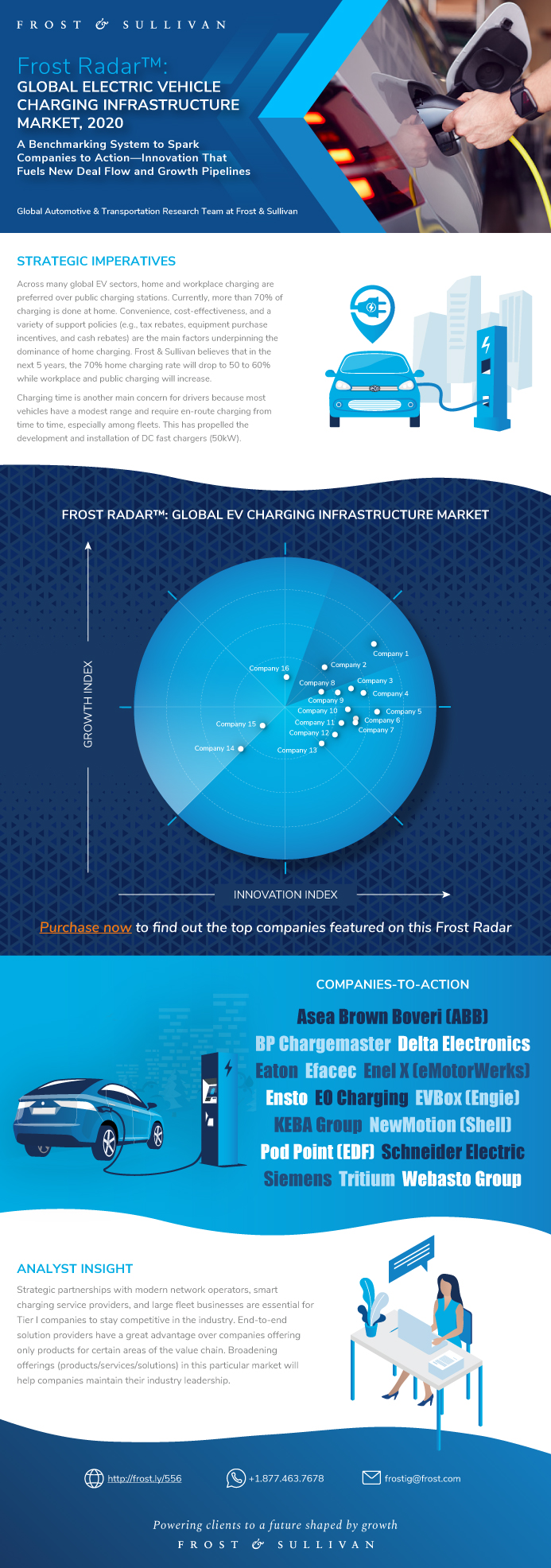Frost Radar™: Global Electric Vehicle Charging Infrastructure Market, 2020
Frost Radar™: Global Electric Vehicle Charging Infrastructure Market, 2020
A Benchmarking System to Spark Companies to Action—Innovation That Fuels New Deal Flow and Growth Pipelines
27-Nov-2020
Global
$4,950.00
Special Price $3,712.50 save 25 %
Description
Many surveys conducted across the globe indicate one common issue tied to electric vehicles (EVs): drivers fear not finding a suitable charging station when needed. Globally, increasing demand for EVs has created significant need for more charging points. About 7.3 million chargers are active across the world (as of 2019), of which, nearly 6.5 million are private chargers, 0.6 million are public slow chargers, and 0.26 million are public fast chargers. China accounts for about 37%, 50%, and 81% of global private, public slow, and public fast chargers, respectively.
Across many global EV markets, home and workplace charging are preferred over public charging stations. Currently, more than 70% of charging is done at home. Convenience, cost-effectiveness, and a variety of support policies (e.g., tax rebates, equipment purchase incentives, and cash rebates) are the main factors underpinning the dominance of home charging. Frost & Sullivan believes that in the next 5 years, the 70% home charging rate will drop to 50 to 60% while workplace and public charging will increase.
Charging time is another main concern for drivers because most vehicles have a modest range and require en-route charging from time to time, especially among fleets. This has propelled the development and installation of DC fast chargers (50kW). Although DC fast chargers speed up the charging process, they create need for improved safety and additional components, such as advanced liquid cooled cables, substations, and battery energy storage systems. Companies with such extensive features and offerings for DC fast charging will have an edge for success in this space. In fact, vendors offering a wide range of products for AC and DC charging stations are witnessing better revenue growth compared to companies restricted to a single segment.
This Frost & Sullivan Radar™ looks at 16 of the leading EV charging infrastructure companies and evaluates them based on growth and innovation leadership. The document presents competitive profiles on each of the companies based on their strengths, opportunities, and market positioning. We discuss strategic market imperatives and the competitive environment that vendors operate in as well as make recommendations each provider should consider to spur growth.
Key Issues Addressed
- Who are the current market leaders in the EV charging infrastructure space?
- Which companies are moving rapidly in market innovation?
- What are the strengths of various companies profiled?
- What kind of opportunities will be created for these companies and how can they align their strengths to benefit and improve their market position?
RESEARCH: INFOGRAPHIC
This infographic presents a brief overview of the research, and highlights the key topics discussed in it.Click image to view it in full size

Table of Contents
Strategic Imperative
Strategic Imperative (continued)
Growth Environment
Growth Environment (continued)
Frost Radar™: Global EV Charging Infrastructure Market
Frost Radar™: Competitive Environment
Frost Radar™: Competitive Environment (continued)
Asea Brown Boveri (ABB)
BP Chargemaster
Delta Electronics
Eaton
Efacec
Enel X (eMotorWerks)
Ensto
EO Charging
EVBox (Engie)
KEBA Group
NewMotion (Shell)
Pod Point (EDF)
Schneider Electric
Siemens
Tritium
Webasto Group
Strategic Insights
Significance of Being on the Frost Radar™
Frost Radar™ Empowers the CEO’s Growth Team
Frost Radar™ Empowers Investors
Frost Radar™ Empowers Customers
Frost Radar™ Empowers the Board of Directors
Frost Radar™: Benchmarking Future Growth Potential
Frost Radar™: Benchmarking Future Growth Potential
Legal Disclaimer
Popular Topics
Key Issues Addressed
- Who are the current market leaders in the EV charging infrastructure space?
- Which companies are moving rapidly in market innovation?
- What are the strengths of various companies profiled?
- What kind of opportunities will be created for these companies and how can they align their strengths to benefit and improve their market position?
| No Index | No |
|---|---|
| Podcast | No |
| Author | Naga Karthik Voruganti |
| Industries | Automotive |
| WIP Number | K545-01-00-00-00 |
| Is Prebook | No |
| GPS Codes | 9800-A6,9882-A6 |
 USD
USD GBP
GBP CNY
CNY EUR
EUR INR
INR JPY
JPY MYR
MYR ZAR
ZAR KRW
KRW THB
THB